Anti-diabetic effects of lactic acid bacteria in normal and type 2 diabetic mice
- PMID: 22962525
- PMCID: PMC3432833
- DOI: 10.3164/jcbn.11-07
Anti-diabetic effects of lactic acid bacteria in normal and type 2 diabetic mice
Abstract
The antidiabetic effects of lactic acid bacteria were investigated using mice. In Experiment 1, normal ICR mice were loaded with sucrose or starch with or without viable Lactobacillus rhamnosus GG cells. GG significantly inhibited postprandial blood glucose levels when administered with sucrose or starch. In Experiment 2, KK-A(y) mice, a model of genetic type 2 diabetes, were given a basal diet containing viable GG cells or viable Lactobacillus delbrueckii subsp. bulgaricus cells for 6 weeks. Viable GG cells significantly inhibited fasting blood glucose, postprandial blood glucose in a glucose tolerance test and HbA1c. Such effects were not shown by viable L. bulgaricus cells. In Experiment 3, the KK-A(y) mice were given a basal diet containing viable GG cells or heat-treated GG cells for 3 weeks. The viable GG cells significantly suppressed fasting blood glucose and impaired glucose tolerance, but the heat-treated GG showed no effects. These results demonstrated that GG decreased the postprandial blood glucose in ICR mice, and that the antidiabetic activity of lactic acid bacteria on the KK-A(y) mice differed depending on the bacterial strain and whether the bacterium is viable when it arrives in the intestine. In the present study, we conclude that the antidiabetic activity may result from continuous inhibition of the postprandial blood glucose through suppression of glucose absorption from the intestine. These findings indicate that specific strains of lactic acid bacterium can be expected to be beneficial for the management of type 2 diabetes.
Keywords: KK-Ay mouse; Lactobacillus rhamnosus GG; antidiabetic effects; glucose tolerance test; lactic acid bacterium.
Figures
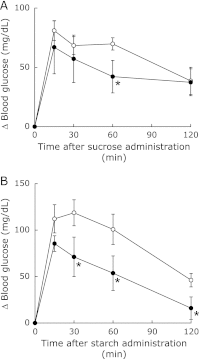
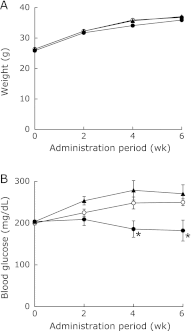
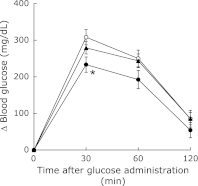
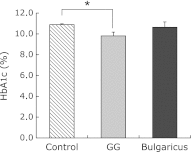
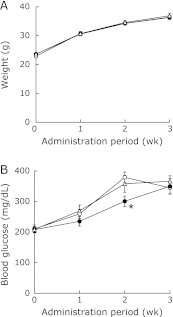
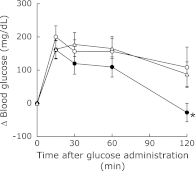
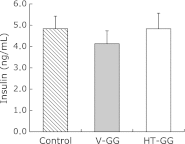
Similar articles
-
Anti-diabetic effects of globin digest and its active ingredient Leu-Ser-Glu-Leu in ICR mice, streptozotocin-induced diabetic mice and KK-Ay mice.Life Sci. 2010 Mar 13;86(11-12):424-34. doi: 10.1016/j.lfs.2010.01.014. Epub 2010 Jan 25. Life Sci. 2010. PMID: 20109472
-
Antidiabetic effects of corosolic acid in KK-Ay diabetic mice.Biol Pharm Bull. 2006 Mar;29(3):585-7. doi: 10.1248/bpb.29.585. Biol Pharm Bull. 2006. PMID: 16508174
-
Antidiabetic effect of Nitobegiku, the herb Tithonia diversifolia, in KK-Ay diabetic mice.Biol Pharm Bull. 2005 Nov;28(11):2152-4. doi: 10.1248/bpb.28.2152. Biol Pharm Bull. 2005. PMID: 16272709
-
Antidiabetic effect of glycyrrhizin in genetically diabetic KK-Ay mice.Biol Pharm Bull. 2001 May;24(5):484-7. doi: 10.1248/bpb.24.484. Biol Pharm Bull. 2001. PMID: 11379765
-
Hypoglycemic effect of hot-water extract of adzuki (Vigna angularis) in spontaneously diabetic KK-A(y) mice.Nutrition. 2009 Feb;25(2):134-41. doi: 10.1016/j.nut.2008.08.001. Epub 2008 Oct 16. Nutrition. 2009. PMID: 18929464
Cited by
-
Milk Fermented with Pediococcus acidilactici Strain BE Improves High Blood Glucose Levels and Pancreatic Beta-Cell Function in Diabetic Rats.Food Sci Anim Resour. 2023 Jan;43(1):170-183. doi: 10.5851/kosfa.2022.e69. Epub 2023 Jan 1. Food Sci Anim Resour. 2023. PMID: 36789203 Free PMC article.
-
The impact of dietary fructose on gut permeability, microbiota, abdominal adiposity, insulin signaling and reproductive function.Heliyon. 2023 Aug 9;9(8):e18896. doi: 10.1016/j.heliyon.2023.e18896. eCollection 2023 Aug. Heliyon. 2023. PMID: 37636431 Free PMC article.
-
Pharmaceutical significance of Leuconostoc mesenteroides KS-TN11 isolated from Nile Tilapia, Oreochromis niloticus.Saudi Pharm J. 2018 May;26(4):509-514. doi: 10.1016/j.jsps.2018.02.006. Epub 2018 Feb 6. Saudi Pharm J. 2018. PMID: 29844722 Free PMC article.
-
Some current applications, limitations and future perspectives of lactic acid bacteria as probiotics.Food Nutr Res. 2017 May 3;61(1):1318034. doi: 10.1080/16546628.2017.1318034. eCollection 2017. Food Nutr Res. 2017. PMID: 28659729 Free PMC article. Review.
-
Acute Pre- and Post-administration of Lactiplantibacillus plantarum 2034 and Its Secretory Metabolites Ameliorates Hyperglycaemia, Hyperlipidaemia, and Oxidative Stress in Diabetic Rats.Probiotics Antimicrob Proteins. 2024 Aug 16. doi: 10.1007/s12602-024-10343-y. Online ahead of print. Probiotics Antimicrob Proteins. 2024. PMID: 39150651
References
-
- Fuller R. Probiotics in man and animals. J Appl Bacteriol. 1989;66:365–378. - PubMed
-
- Yoshida Y, Seki T, Matsunaka H, et al. Clinical effects of probiotic Bifidobacterium breve supplementation in adult patients with atopic dermatitis. Yonago Acta Medica. 2010;53:37–45.
-
- Goldin BR, Gorbach SL, Saxelin M, Barakat S, Gualtieri L, Salminen S. Survival of Lactobacillus species (strain GG) in human gastrointestinal tract. Dig Dis Sci. 1992;37:121–128. - PubMed
-
- Hilton E, Kolakowski P, Singer C, Smith M. Efficacy of Lactobacillus GG as a diarrheal preventive in travelers. J Travel Med. 1997;4:41–43. - PubMed
-
- Goldin BR, Gualtieri LJ, Moore RP. The effect of Lactobacillus GG on the inhibition and promotion of DMH-induced intestinal tumors in the rat. Nutr Cancer. 1996;25:197–204. - PubMed
LinkOut - more resources
Full Text Sources
Other Literature Sources

